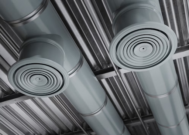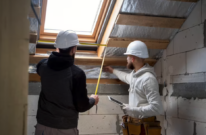5 Excellent Alternative Materials for Wood in Construction


Sam Willis
Sam Willis is an esteemed BPA Advisor and Editor specializing in Restoration & Remodeling. As a dedicated writer, Sam takes pride in sharing his extensive knowledge and expertise in residential and commercial construction, as well as restoration & remodeling. Sam plays a crucial role in offering valuable insights that shape the discourse around innovative construction practices and materials.
There is no denying the timeless beauty that wood can add to a construction project. In addition, wood is a rather versatile material that can be used for a wide array of purposes, both interior and exterior.
However, with the entire country on the lookout for ways to mitigate fire risk and create more sustainable structures, the high-maintenance requirements of wood are causing homeowners and commercial builders alike to explore their options. With this in mind, keep reading for 5 excellent alternative materials for wood in construction.
1. Steel

Topping the list of wood alternatives in construction is steel. Long renowned for its utility and durability in industrial and warehousing applications, steel is gaining major traction for all construction types--residential included. Many modern forms of steel siding can be fabricated in colors and designs nearly indistinguishable from natural wood, making them a great choice for homeowners who want a rustic aspect with none of the maintenance and upkeep concerns of wood. Among the benefits of steel as a construction material include:
- Elite resistance to fire, impact, rot, and pest damage, helping owners achieve lower insurance premiums
- Highly reflective of sun to prevent heat from being stored and released into the building interior during the year’s warmer months
- Pre-engineered metal buildings (PEMBs) can be partially fabricated off site, resulting in shorter project timelines and lower labor costs
- Durable enough to last 100 years or more and recyclable if necessary
A downside to choosing metal is that the initial cost for some metal materials, such as steel log siding, can be higher than that of wood. However, when lifetime costs of maintenance are factored in, the total price is very competitive. In addition, metal can be noisier than wood and similar building materials.
2. Concrete

Insulated concrete forms (ICF) are gaining popularity as a sustainable framing solution. Employing insulative framing panels that lock in place at the construction site and set with concrete, ICF framing offers many advantages over traditional wood panels. For example, the monolithic concrete wall provides an elite air and moisture barrier that more porous wood framing cannot match. In addition, the insulative core provides a decoupling effect that gives ICF framing one of the highest R-values on the market, ensuring stable interior temperatures in the face of extreme weather conditions.
However, as concrete is the world’s most prevalent construction material, there are obviously more applications than just ICF. Concrete is everywhere in construction. From foundations to flooring substrates, driveways to sidewalks, concrete is a classic, durable construction material that performs well in most climates. If there is one drawback to concrete, it is that it does have a tendency to absorb moisture, so it is important to apply crystalline waterproofing or some other form of concrete sealer to ensure optimal results.
3. Stone
Outside of wood, stone is arguably the most rustic building material on the market. It has the unique distinction of being both durable and breathtaking. From cobblestone walkways to brick siding, stone chimneys to flagstone patios, there are countless ways that stone can take a property to the next level.
There are a couple of points to keep in mind when choosing stone, however. Like concrete, stone can be porous, so it is important to keep it regularly sealed to prevent damage during the freeze/thaw cycle. In addition, stone is usually heavy and difficult to work with, often requiring the assistance of professional masons for installation.
To help combat some of these concerns, many companies are fabricating innovative stone veneer products. For example, a modern brick cladding system has the appearance of natural brick siding but is actually just a thin brick masonry veneer applied above insulative and water-resistant barriers, guaranteeing that building owners can get the desired brick appearance with none of the porosity concerns.
4. Composites
As their name implies, composite building materials are a combination of several different materials. This usually results in better performance than the component materials could achieve individually--usually through increased insulation, better fire resistance, or longer-lasting durability. For example, composite roofing tiles are usually fabricated from a combination of asphalt, fiberglass, and recycled plastic polymers to provide homes with a classy roofing option that doesn’t fade in the sun or blister upon impact.
Fiber cement is one of the most popular lumber alternatives for siding because it can closely resemble natural wood but is made from a combination of sand, portland cement, and cellulose fibers that provide the highest quality fire and pest resistance on the market.
There are composite materials for flooring, decking, window frames, and basically any other application you can think of, so be on the lookout for these innovative options if you want something longer lasting and lower maintenance than wood.
5. Recycled Materials
As in all walks of life, the construction industry is looking for unique ways to recycle and upcycle products. For example, denim insulation takes waste from old clothing and forms it into insulation batts that are surprisingly high in R-value. The cork from old wine stoppers is being turned into flooring that rivals hardwood along many important lines, while recycled plastic is being used in furniture creation. The possibilities are immense, so be sure to explore some of these outside-the-box options the next time you are considering a wood alternative.
Explore Options Other Than Wood for Your Next Construction Project
Thanks to its rustic beauty and versatility, wood will likely remain a top construction material for the foreseeable future. However, with the construction industry eyeing more greater sustainability and reduced disaster risk, other more durable materials are moving to the forefront. To this effect, steel, concrete, stone, composites, and recycled materials are 5 excellent options to consider over wood for your next construction project.
Get Smarter About Building Products
Join 50,000+ subscribers and get our 3 min daily newsletter on what matters in the building materials industry.
You might like this


Solving Ventilation Challenges: Metal Deck Profiles and Back Draft Dampers as Key Solutions
When it comes to building design and construction, ventilation is a critical factor that often presents significant challenges. Proper ventilation is essential for maintaining indoor air quality, controlling temperature, and ensuring occupant comfort and safety. In this article, we will explore how metal deck profiles and back draft dampers are key solutions for addressing ventilation […]


The Ultimate Guide to Home Insulation
When it comes to creating a comfortable and energy-efficient home, insulation plays a pivotal role. Proper insulation helps regulate indoor temperatures, reduces energy consumption, and enhances overall comfort. In this comprehensive guide, we’ll explore various aspects of home insulation, including the best types of insulation for different areas of your home and key considerations for […]


The Best Hidden Deck Fasteners: Concealed Elegance and Lasting Stability
Decks, those quintessential outdoor havens, serve as extensions of our living spaces, inviting us to bask in the open air. But what if we could take this experience to the next level? Enter concealed deck fasteners, the unsung heroes that elevate your deck’s appearance and structural integrity, all while keeping their existence a secret. In […]